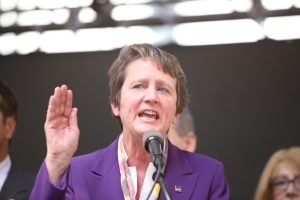Heading into a new year of protests and general unruliness, the Service Employees International Union’s (SEIU) Fight for $15 has produced plenty of predictions that hold no water now. Here are the three dumbest forecasts:
- Workers will flock to the SEIU. In orchestrating the Fight for $15, the SEIU’s primary goal—aside from a $15 an hour minimum wage—is to increase its membership rolls and dues collection. Take this SEIU statement: “[We support] the ability of all workers across our economy to join together in unions and have a voice at work to improve their lives and the lives of their families and communities, including organizers in the Fight for $15.” Or this from SEIU President Mary Kay Henry: “I think we’re going to see additional workers join from across the retail sector, from auto parts work, from airports. We’re joining with the immigration movement, with Black Lives Matter, the environmental movement…” Yet recent LM-2 filings show that the SEIU’s membership dropped from 1,893,775 employees in 2014 to 1,887,941 in 2015. The union’s membership has generally declined over the past five years: It claimed 1,921,786 union members in 2011, the year prior to the start of the Fight for $15—almost 34,000 more than it had in 2015.
- A $15 minimum wage won’t cost jobs. Yeah, right. Lawrence Mishel, president of the SEIU-backed Economic Policy Institute, says that a $15 minimum wage is “something the economy can afford.” Well, small business owners definitely can’t—at least, not without raising prices and/or firing people. Just take a look at FacesOf15.com, which chronicles the $15 minimum wage’s adverse effects on job creators in cities like San Francisco and Seattle. The Heritage Foundation’s James Sherk estimates that a federal $15 minimum wage would eliminate seven million jobs nationwide.
- It saves taxpayers money. Union activists often claim that a higher minimum wage makes fewer people dependent on public assistance, saving taxpayers money in the end. In union activist Kent Siladi’s words: “Taxpayers also effectively subsidize the employers of low-wage workers who remain in poverty.” Yet research from California and New York—which embraced a $15 minimum wage earlier this year—points to a much heavier tax burden. According to a California legislative analysis, a $15 minimum wage for government employees will eventually cost taxpayers an additional $3.6 billion in annual taxes. In New York, the higher wage floor will cost taxpayers an extra $838 million a year in Medicaid payments alone.
Stay tuned for more facepalms in 2017.




